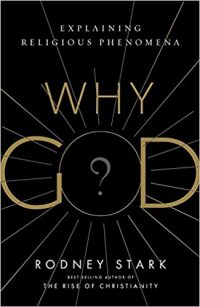 “Why God? Explaining Religious Phenomena”
“Why God? Explaining Religious Phenomena”
by Rodney Stark.
Templeton Press (Conshohocken, Pennsylvania, 2017).
293 pp., $24.95.
“Most humans believe (and hope) that life has meaning.” That affirmation appears in the list of basic propositions that form the core around which Rodney Stark, a widely known sociologist of religion, builds his new book, “Why God?”
Stark’s central question is “Why are most people religious?” He states in the final proposition on his lengthy list — No. 192, to be exact — that “the everlasting basis for religion will be the human conviction and hope that life has meaning.”
[hotblock]
Writing as a social scientist, Stark endeavors “to explain the human side of religion,” which he calls “the only aspect of religion available to social science.” His book’s aim, then, is not to convert, to catechize or to bring faith to life for readers, as many books in the religious realm aim to do.
Rather, for the most part he attempts to view religions from the outside looking in, so to speak. He asks: “Why do people believe in gods? Why do they pray? How do revelations occur?”
This book is meant, then, for those who wonder why religions ever developed in the world and why such vast numbers of the world’s citizens consider religion a life essential. Whether or not Stark considers religion an essential part of his own life is apparently beside the point here.
Yet, Stark is not a complete outsider to religion, having been raised within the Christian tradition and holding strong opinions about certain contemporary trends among Christians.
So this book is not devoid of passion for religion. Indeed, Stark passionately rejects any notion that a religion can be godless, stating that “all attempts to sustain godless religions are a resounding failure.”
I wondered in reading “Why God?” if it might just as well be titled “Why Religion?” Clearly, though, its actual title reflects a strong stance that the author wants to assert uncompromisingly. He rejects the notion that “various philosophies of life such as secular humanism, existentialism or, indeed science” can be identified as religious.
“Religious organizations will often fail due to an insufficient image of God,” Stark writes.
In fact, in defining the term “religion,” he states: “A religion consists of a very general explanation of being (metaphysics) predicated on the existence of a god or gods, and including the terms of exchange with a god or gods (theology).”
These terms of exchange encompass a religion’s expectations of believers, as well as the rewards expected of their faith commitment.
Stark co-directs the Institute for Studies of Religion at Baylor University in Waco, Texas, a Christian university founded in the Baptist tradition. He is well known to social scientists who study the basic phenomena of religion and at times seems intent on addressing them directly.
But the range of his concerns in “Why God?” is broad, reaching far back in time to the origins of various religions, but commenting also on new religious movements.
Some of his conclusions may surprise readers. For example, in discussing how a religion’s membership grows, he contests the view that Christianity’s growth in its early centuries was nothing short of miraculous. He holds that “there was plenty of time for Christianity to achieve” the membership reached by the fourth century through a conventional growth process.
Among numerous other points of interest, Stark discusses:
— Monotheism’s importance. “Only a God of infinite scope seems able to be a moral force,” he comments. He says it takes “a God of infinite scope” to demand “a lifelong, exclusive, obedient relationship.”
— New religious movements: These, he concludes, contrary to popular views, tend not to be launched by the suffering poor but by “people of privilege who suffer from spiritual deprivation.” He believes one common cause of spiritual deprivation “is the increasingly vague image of God presented by a monopoly religion.”
— Mental illness: Stark labels “false” the notion that people suffering poor mental health tend more than others to be drawn to religion. Instead, he states, “people with poor mental health tend to be less religious.”
A key point in “Why God?” that some may want to discuss further involves Stark’s complex examination of what he calls high- and low-tension religious groups. “All religious organizations can be located along an axis of tension between the group and its sociocultural environment,” he observes.
This tension relates to “the degree of distinctiveness, separation and antagonism between a religious organization” and its cultural environment. America, Stark notes, “was founded by members of high-tension sects.” But as time passed, many “began to lower their tension.”
Stark examines a tendency among “religious organizations to continue moving from higher to lower tension” in order to satisfy members’ wishes. Due to this, there tends “to be an oversupply of low-tension religious organizations.” But at some point, he indicates, “low-tension religious organizations” typically experience “declining membership.”
What that implies or does not imply for contemporary believers — for how their relationship with the surrounding world impacts their faith lives for the worse or the better — is not a new issue. It is likely, however, that believers still will be debating it far into the future.
***
Gibson was the founding editor of Origins, Catholic News Service’s documentary service. He retired in 2007 after holding that post for 36 years.
PREVIOUS: Priest: ‘Ninja’ show a way to proclaim Gospel using his God-given talents
NEXT: Graphic gore obscures poignant AI/human conflict in ‘Upgrade’



Share this story